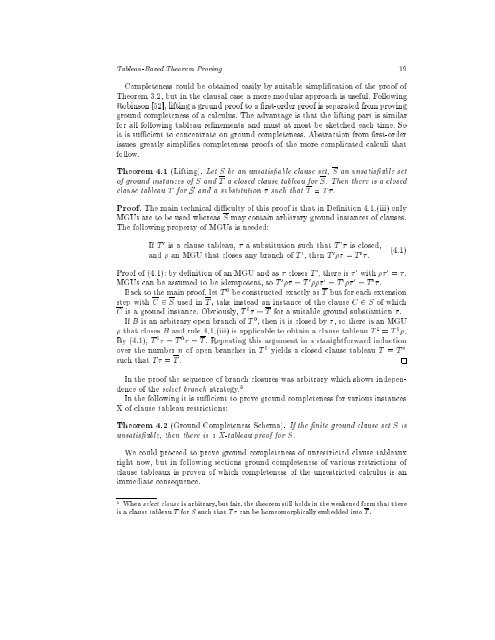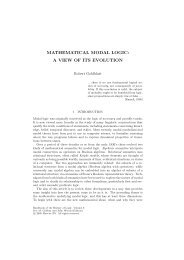You also want an ePaper? Increase the reach of your titles
YUMPU automatically turns print PDFs into web optimized ePapers that Google loves.
<strong>Tableau</strong>-<strong>Based</strong> <strong>Theorem</strong> <strong>Proving</strong> 19Completeness could be obtained easily by suitable simplication of the proof of<strong>Theorem</strong> 3.2, but in the clausal case a more modular approach is useful. FollowingRobinson [52], lifting a ground proof to a rst-order proof is separated from provingground completeness of a calculus. The advantage is that the lifting part is similarfor all following tableau renements and must at most be sketched each time. Soit is sucient to concentrate on ground completeness. Abstraction from rst-orderissues greatly simplies completeness proofs of the more complicated calculi thatfollow.<strong>Theorem</strong> 4.1 (Lifting). Let S be an unsatisable clause set, S an unsatisable setof ground instances of S and T a closed clause tableau for S. Then there is a closedclause tableau T for S and a substitution such that T = T.Proof. The main technical diculty of this proof is that in Denition 4.1.(iii) onlyMGUs are to be used whereas S may contain arbitrary ground instances of clauses.The following property of MGUs is needed:If T 0 is a clause tableau, a substitution such that T 0 is closed,and an MGU that closes any branch ofT 0 , then T 0 = T 0 .(4.1)Proof of (4.1): by denition of an MGU and as closes T 0 , there is 0 with 0 = .MGUs can be assumed to be idempotent, so T 0 = T 0 0 = T 0 0 = T 0 .Back to the main proof, let T 0 be constructed exactly as T but for each extensionstep with C 2 S used in T , take instead an instance of the clause C 2 S of whichC is a ground instance. Obviously, T 0 = T for a suitable ground substitution .If B is an arbitrary open branch ofT 0 , then it is closed by , so there is an MGU that closes B and rule 4.1.(iii) is applicable to obtain a clause tableau T 1 = T 0 .By (4.1), T 1 = T 0 = T . Repeating this argument in a straightforward inductionover the number n of open branches in T 0 yields a closed clause tableau T = T nsuch that T = T .In the proof the sequence of branch closures was arbitrary which shows independenceof the select branch strategy. 5In the following it is sucient to prove ground completeness for various instancesX of clause tableau restrictions:<strong>Theorem</strong> 4.2 (Ground Completeness Schema). If the nite ground clause set S isunsatisable, then there is a X-tableau proof for S.We could proceed to prove ground completeness of unrestricted clause tableauxright now, but in following sections ground completeness of various restrictions ofclause tableaux is proven of which completeness of the unrestricted calculus is animmediate consequence.5 When select clause is arbitrary, but fair, the theorem still holds in the weakened form that thereis a clause tableau T for S such that T can be homeomorphically embedded into T .
















